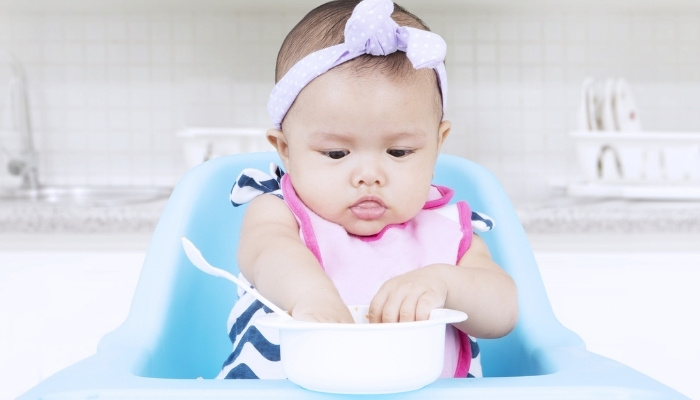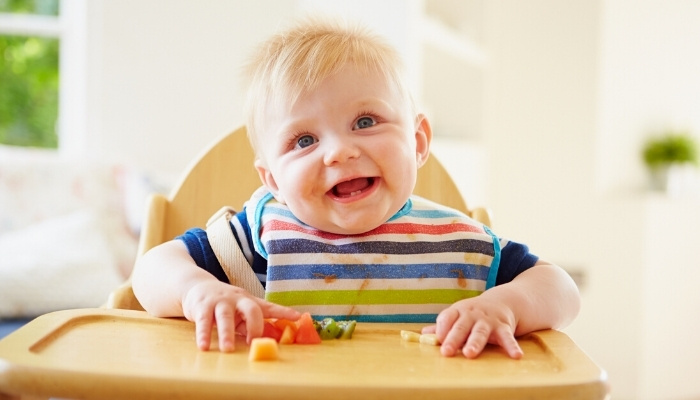A newborn requires only breastmilk, formula, or a combination of both until they are six months old. After this time, parents can choose to supplement their baby’s diet with solid foods.
A popular method of solid food integration is Baby-led weaning (BLW). Baby-led weaning is when parents skip spoon-feeding and purees in favor of finger foods that a baby feeds to themselves.
The concept can seem intimidating, but we’ve compiled this comprehensive guide on how and when to start baby-led weaning for your child.
1. Know the Benefits of Baby-Led Weaning
Baby-led weaning is popular among parents, pediatricians, and experts in the field for good reason. There are many advantages to allowing your little one to take the lead when it comes to food.
Affordability
Since baby-led weaning relies on the use of solid foods, there is no need to buy branded baby food purees, pouches, or blenders. The average baby goes through around 2,500 ounces of pureed foods in six months following other methods.
At an average of $1.63 for an 8-ounce jar of the leading baby food brand, that’s a total of $500.00 over the course of the baby’s first six months of eating solid foods.
In contrast, baby-led weaning encourages a variety of simple foods that you likely have on hand in the kitchen or are already part of your diet. This means no new additions to your weekly grocery list and limited additional expenses.
Self-Regulation
Baby-led weaning is based on the concept of allowing your baby to lead the way when it comes to mealtimes. This encourages a baby to acknowledge when they’re hungry, how much they need to eat, and the pace at which to eat it.
Research has shown that allowing a baby to eat at their own rate fosters their natural appetite regulation. So, BLW is beneficial because it encourages your child to eat when they’re hungry and stop when they’re full.
Nutritional Variety
Baby-led weaning is the best way to combat picky eating habits. By the time your child is a year old, they will have tried a large variety of different flavor profiles, textures, and food groups.
Long-term repetitive exposure to typically disliked foods, such as vegetables and proteins, can lead to the development of a more sophisticated palette. Additionally, it can limit food aversions and even work to reduce the likelihood of food-related allergies.
Inclusion
Part of baby-led weaning is letting your child feed themselves as opposed to a parent feeding them. This encourages full-family inclusion at mealtimes.
Parents get to sit down to a warm plate of food at the same time as their little one. Eventually, your child will create an association and develop a routine around mealtimes. This also helps foster natural rhythms of appetite and closer family bonds.
Skill Development
Several fine motor skills are practiced and perfected as a result of baby-led weaning. Your child will learn to chew, swallow, grip foods, and strengthen hand-eye coordination.
This development will be learned on an earlier timeline than if pureed foods or spoon-feeding methods were implemented.
Independence
Baby-led weaning encourages your child to explore food at their own pace and in their own way. This means that, for them, eating is fun!
It gives them the opportunity to get messy, experience different textures, put things in their mouth safely, and be in control of their own body for the first time.
Children with heightened senses of independence often excel in other areas of development.
2. Assess and Determine Baby Readiness
Baby-led weaning starts by deciding whether your child is actually ready to take this step, both developmentally and nutritionally. Consulting with your pediatrician is always the best idea, but here are a few guidelines to help you assess at home.
Age
Your child should be at least six months of age before introducing any solid foods. Prior to this point, their diet should consist exclusively of breastmilk or formula.
Their digestive system is not developed enough to handle solid foods until they’re six months or older.
Additionally, there is no need for supplemental nutrition prior to six months, as they receive all of their needed daily requirements from breastmilk or formula.
Development
There are several small developmental milestones your child should meet before introducing solids. Meeting these expectations means that your child can likely safely start on solid foods.
- Showing an interest: If your baby watches you eat, reaches for your food, or mimics the movement of your mouth, then they’re expressing an interest in eating.
- Ability to chew and keep food in their mouth: These developments often go hand-in-hand. If your baby is chewing and able to keep food in their mouth, it means they likely possess the tongue and jaw control needed to eat solids.
- Sitting up unsupported with good neck control: If your baby cannot sit up on their own, it is an indication that they’re not ready to begin eating solids. The same applies if they lack proper neck control.

3. Basics of Baby-Led Weaning
Once you’ve determined that baby-led weaning is the best choice for your family, it’s time to get into the basic principles.
Understanding fundamental safety, nutritional, and developmental concepts can help boost your confidence in knowing how to start baby-led weaning.
Understanding Safety Concepts
Keeping your child safe as they explore solid foods is the number one priority. Here are a few general guidelines:
- No teeth mean soft foods only: Any food you give your baby should be soft. If you can’t squish it between your fingers, they can’t chew it with their gums. This doesn’t mean avoiding hard fruits and vegetables; rather, you can soften them by baking or cooking.
- Avoid choking hazards: Just because a food is soft doesn’t mean it’s safe. All foods should be cut into smaller pieces so they won’t caught in the baby’s throat if accidentally swallowed whole. Foods like grapes, nuts, hotdogs, and popcorn pose the largest threat.
- Meals should be supervised: Never leave your child alone while they’re eating. All meals, no matter how safe or small, should be supervised by an adult. Choking is a silent activity, and if you’re not there to see the signs, it could be detrimental to your child’s health.
- Be prepared for an emergency: Take a first aid class geared toward infants and children. Doing so ensures that you can identify and respond to crisis situations like choking. Have a plan in place for when/if something happens.
Planning Meals With Intention
Planning your child’s meals with intention is vital to their development. We’ve compiled a small list of tips to help you prep:
- Solid foods do not replace breastmilk/formula: For the first year of life, breastmilk or formula is the primary source of nutrition. Introducing solid foods is meant to complement the existing diet. Your child will still need formula/breast milk quantities required for their age.
- Make it a point to introduce common aversions early: Vegetables and proteins are the most common toddler food aversions. Introducing these foods early and often is the key to combating picky eating habits. Try to serve one portion of protein and one of vegetables alongside two portions of preferred foods, such as fruits or dairy.
- Have your baby eat what you’re eating: Don’t make it a habit of cooking separate meals for your little one. Instead, introduce them to the foods that you eat daily. This not only helps mitigate food costs but encourages a variety of foods that help develop a sophisticated palette.
Conclusion
At the end of the first six months of BLW, you’ll notice that your child has become a pro at the dinner table.
Ideally, they’ll have established a feeding routine, possess an expanded palette of preferred foods, mastered the skill of feeding themselves, and be working on using utensils.
These habits foster healthy relationships between your child and their nutrition.
Mom of three (including identical twin boys), wife, and owner of Parents Wonder. This is my place to share my journey as a mother and the helpful insights I learn along the way.

